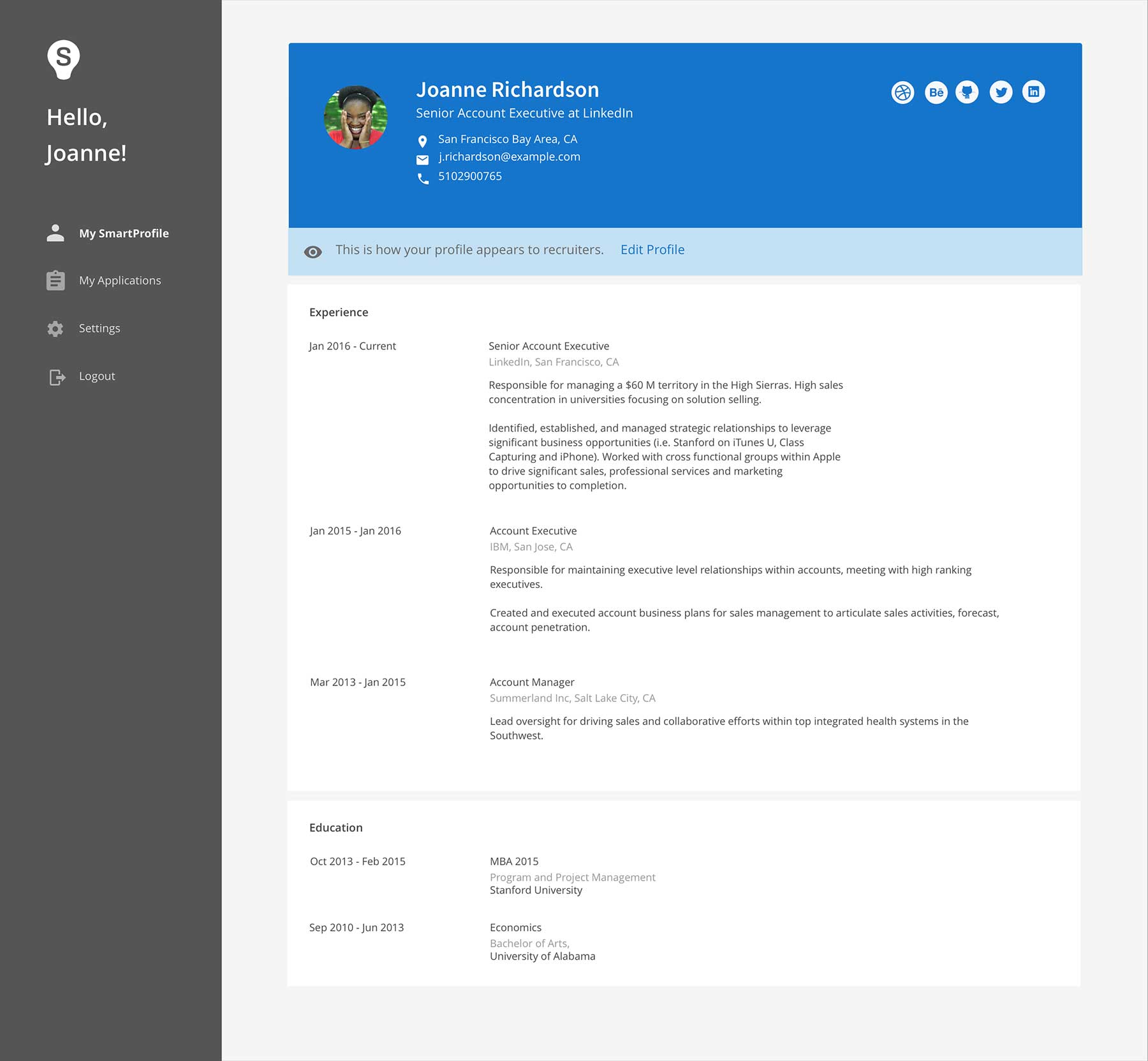Datenschutzerklärung
Last reviewed: March 27, 2020
Welche persönlichen Daten („Ihre persönlichen Daten“) werden gesammelt?
- Daten, die Sie („Sie“, „Ihr/e“) im Rahmen der Bewerbung oder der Jobalarm-Erstellung eingeben (Kontaktinformationen, Erfahrung und Ausbildung, Anhänge, Antworten auf Screeningfragen).
- Ihre IP-Adresse.
- Ihre Anmeldeinformationen (E-Mail-Adresse und verschlüsseltes Passwort) für das Bewerberportal.
- Cookies, welche uns einen Einblick auf den Zugriff auf sowie die Verwendung unserer Dienstleistungen bieten.
Klicken Sie für weitere Informationen.
Aus welchem Grund werden Ihre persönlichen Daten gesammelt?
- Hilfe bei der Verwaltung Ihrer Berufschancen: Wenn Sie sich bewerben, haben Sie Zugriff auf ein Bewerberportal, in dem Sie Ihre Profil- und Bewerbungsinformationen einsehen und Vorschläge zu Jobs erhalten können. In diesem Fall agieren wir als Datenverantwortlicher.
- Jobvorschläge, die von und über SmartRecruiters verfügbar sind.
- Meinungsumfragen: Sie werden unter Umständen im Rahmen von Meinungsumfragen zu aktuellen oder künftigen SmartRecruiters-Funktionen sowie Ihrer Nutzererfahrung mit SmartRecruiters kontaktiert.
- Verbesserung und Weiterentwicklung der Dienstleistungen und Produkte: SmartRecruiters kann die persönlichen Daten zur Verbesserung und Weiterentwicklung seiner Dienstleistungen und Produkte verwenden, soweit dies erforderlich ist.
In diesem Fall sind wir der Datenverantwortliche.
Bitte beachten Sie: Wenn Sie sich auf Stellenangebote unserer Kunden bewerben, kann unser Kunde (der Recruiter oder Hiring-Manager) Sie für die vorhandenen Beschäftigungsmöglichkeiten in Betracht ziehen und dabei die von SmartRecruiters angebotenen Tools zur Nachverfolgung von Kandidaten, zur Verwaltung und zur Entscheidungsfindung verwenden. In diesem Fall agiert der Kunde als Datenverantwortlicher und SmartRecruiters als Auftragsverarbeiter des Kunden.
SmartRecruiters ist kein Headhunting-Unternehmen. Wir bieten unseren Kunden lediglich eine Technologie zur Mitarbeiterakquise und Ihnen die oben beschriebenen Dienste.
SmartRecruiters bietet Ihnen echte Kontrolle über die Verwendung Ihrer persönlichen Daten und möchte Vertrauen und eine Bindung zu Ihnen aufbauen. Aus diesem Grund bildet Ihre Einwilligung die rechtmäßige Basis für die Verarbeitung Ihrer persönlichen Daten.
Sie können Ihre Einwilligung jederzeit zurückziehen, indem Sie entweder Ihre Bewerbung rückgängig machen oder Ihr Profil löschen.
Wie werden Ihre persönlichen Daten für das Bewerberportal verwendet?
- Sie können ein persönliches Konto einrichten („Bewerberportal“), um Stellenangebote zu verwalten und einen Überblick über Ihre Bewerbungen bei einem oder mehreren Kunden zu haben.
- Um das Bewerberportal unter https://my.smartrecruiters.com/ zu verwenden, können Sie sich über die E-Mail registrieren, die Sie nach einer Bewerbung oder zur Einholung Ihrer Einwilligung erhalten haben. Das Bewerberportal wird in eigener Verantwortung durch SmartRecruiters betrieben. Für die Registrierung benötigen Sie Ihre E-Mail-Adresse sowie ein Passwort.
- Ihr Profil wird für Kunden verfügbar und sichtbar gemacht, bei denen Sie sich bewerben. Sie erhalten Jobalarme von den Kunden, bei denen Sie sich beworben haben.
- Um Ihnen und den Kunden die bestmöglichen Dienstleistungen bieten zu können, nimmt SmartRecruiters für statistische Analysen, den technischen Support und das Datenhosting Drittanbieter in Anspruch. Klicken Sie für weitere Informationen auf
- Die Informationen zu Ihren Bewerbungen werden von SmartRecruiters gesammelt und Ihnen über das Bewerberportal zur Verfügung gestellt.
- Weitere Einzelheiten finden Sie unter. SmartRecruiters verpflichtet sich, die gesammelten persönlichen Daten niemals gegen Geld zu veräußern.
So können Sie Ihre persönlichen Daten selbst verwalten
- Bewerberportal: Sie können Ihr Profil sowie all Ihre Bewerbungen einsehen
- Recht auf Berichtigung: Sie können Ihr Profil bearbeiten, indem Sie zum Bereich „Mein SmartProfile“ navigieren


- Recht auf Löschung: Sie können Ihr Profil bei jedem Unternehmen, bei dem Sie sich beworben haben, zurückziehen und löschen




Bitte beachten Sie, dass SmartRecruiters Ihre Anfrage an die Kunden, bei denen Sie sich beworben haben, weiterleiten wird. In einigen Fällen kann es vorkommen, dass die Kunden beschließen, Ihre Bewerbungsdaten in Übereinstimmung mit ihren eigenen gesetzlichen Verpflichtungen aufzubewahren. Um mehr über die Verpflichtungen zu erfahren, empfehlen wir Ihnen, sich direkt an die betroffenen Kunden zu wenden. Die Kontaktinformationen der relevanten Kunden finden Sie in der Datenschutzerklärung der Kunden, die am Ende Ihrer Bewerbung verlinkt ist, oder über die Website der Kunden. - Recht auf Datenübertragung: Sie können Ihr Profil in ein maschinell lesbares Format exportieren.


- Widerspruchsrecht: Sie können sich entscheiden, ob Sie ein Bewerberportal erstellen möchten oder nicht. Sie können das Bewerbungsportal wie oben beschrieben löschen. Sie können sich weiterhin auf die Stelle Ihrer Wahl bewerben, ohne ein Bewerberportal einzurichten.
- Recht auf Einschränkung der Verarbeitung: Ihre persönlichen Daten werden ausschließlich für die oben genannten Zwecke verwendet, und Sie können entscheiden, ob Sie ein Bewerberportal erstellen möchten oder nicht. Sie können sich weiterhin auf die Stelle Ihrer Wahl bewerben, ohne ein Bewerberportal einzurichten.
- Recht auf Berichtigung: Sie können Ihr Profil bearbeiten, indem Sie zum Bereich „Mein SmartProfile“ navigieren
- Wenn Sie Fragen zur Verwendung oder zur Selbstverwaltung Ihrer persönlichen Daten haben, wenden Sie sich gerne an
EU-US Datenschutzschild und Schweiz-US Datenschutzschild
SmartRecruiters, Inc. ist mit dem EU-US Datenschutzschild und dem Schweiz-US Datenschutzschild konform. Weitere Details finden Sie in.
Verwendung Ihrer persönlichen Daten [↓]
Anfragen – So können Sie uns kontaktieren
Wenn Sie Anfragen an unsere Kunden zu einer Ihrer Bewerbungen haben, wenden Sie sich bitte direkt an den Kunden. Die Kontaktinformationen der Kunden werden im Bewerberportal angezeigt.
ISchicken Sie bei sonstigen Fragen bitte eine E-Mail an unseren Datenschutzbeauftragten: . SmartRecruiters wird schnellstmöglich reagieren.
Im Falle von ungelösten Problemen hinsichtlich des Datenschutzes oder der Verwendung von Daten haben Sie das Recht, eine Beschwerde bei Ihrer Datenschutzaufsichtsbehörde einzureichen.
******
SmartRecruiters, Inc.
166 Geary St
San Francisco CA 94108
USA






